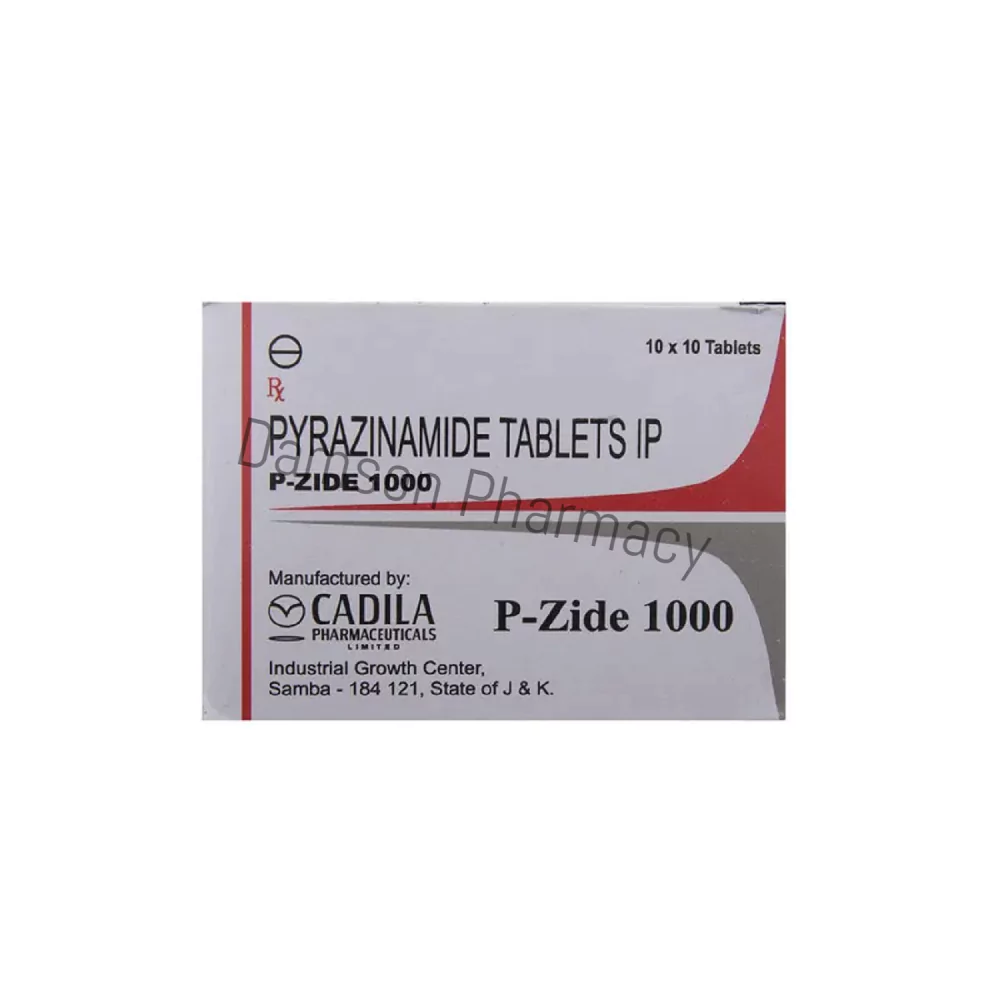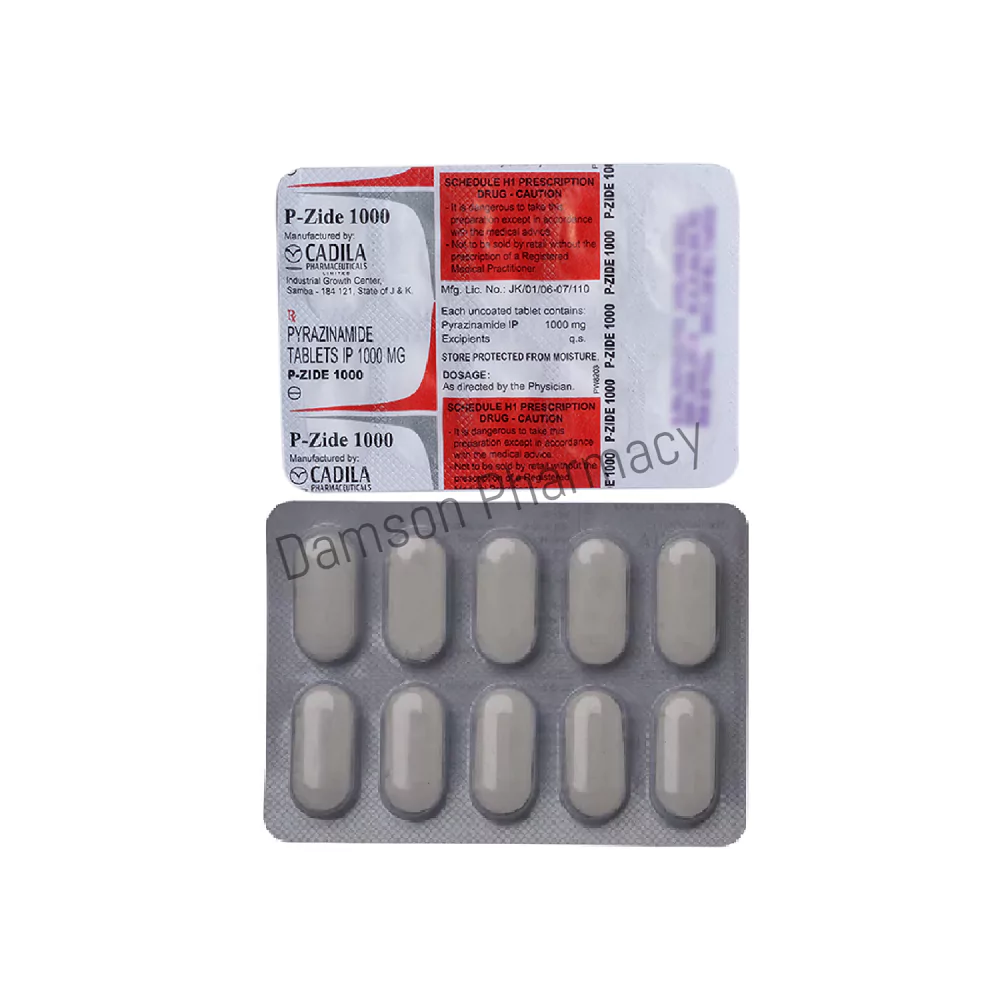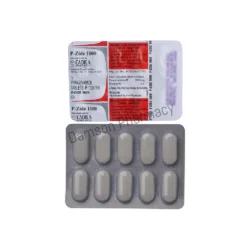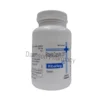P-Zide 1000mg Pyrazinamide Tablets
$70.00 – $180.00Price range: $70.00 through $180.00
| Pack Size | Price | Price / Unit | Quantity | |
|---|---|---|---|---|
| 100 Tablets | $70.00 | $0.70/ unit | ||
| 200 Tablets | $130.00 | $0.65/ unit | ||
| 300 Tablets | $180.00 | $0.60/ unit |
Want to order in bulk / B2B price ? | Send Inquiry |


| SKU | 11469 |
| Manufacturer | Cadila Pharmaceuticals Ltd |
| Categories | Health |
| Delivery Time | 10 - 14 Working Days |
| Strength | 1000mg |
Introduction to Pyrazinamide P- Zide 1000 Tablets
P-Zide 1000mg Pyrazinamide Tablets are prescription medications used in the treatment of tuberculosis (TB), particularly in its initial intensive phase. They are commonly used in combination with other anti-tuberculosis drugs to effectively eliminate the infection and prevent drug resistance.
These tablets contain pyrazinamide, an essential component of first-line TB therapy recommended by global health authorities. They are primarily indicated for use in adults and may also be prescribed to adolescents, under strict medical supervision, based on weight and clinical needs.
P-Zide 1000mg Tablets are not meant to be taken alone and are always part of a multi-drug regimen. The medication is typically taken orally, with or without food, as prescribed by a healthcare provider. Consistency in dosage and timing is crucial for successful TB treatment.
Uses of Pyrazinamide P-Zide 1000
Pyrazinamide, commonly sold under various brand names like P-Zide 1000, is primarily used in the treatment of tuberculosis (TB). Here are the main uses of Pyrazinamide P-Zide 1000 Tablet:
- Treatment of Tuberculosis (TB)
- Combination Therapy
- Shortening Treatment Duration
- Activity Against Dormant Bacteria
- Prevention of Drug Resistance
How Does Pyrazinamide P-Zide 1000 Tablets Works?
P-Zide 1000mg Pyrazinamide Tablets work by targeting and destroying the tuberculosis-causing bacteria, Mycobacterium tuberculosis, especially in acidic environments like those inside infected cells. The active ingredient, pyrazinamide, helps kill dormant bacteria that other TB drugs may not effectively eliminate during the early treatment phase.
By disrupting the bacterial energy production and metabolism, P-Zide 1000mg Pyrazinamide Tablets help reduce the bacterial load rapidly. This allows other TB medications in the combination regimen to work more efficiently, ultimately leading to faster recovery and a reduced chance of drug resistance.
Side Effects of Pyrazinamide P-Zide 1000
Common Side Effects
- Elevated Liver Enzymes
- Nausea
- Vomiting
- Loss of appetite
- Abdominal discomfort
Serious Side Effects
- Hepatotoxicity
- Severe Skin Reactions
- Gout Exacerbation
- Peripheral Neuropathy
- Arthritis
Dosage of Pyrazinamide P-Zide 1000 Tablets
The dosage of Pyrazinamide, including its formulation as P-Zide 1000 Tablet, can vary based on individual patient characteristics, the specific regimen prescribed by the healthcare provider, and the stage of tuberculosis (TB) treatment.
It’s crucial to follow the prescribed dosage and duration of treatment as directed by a qualified healthcare professional. The information provided here is for general reference and may not be applicable to every individual. Always consult with your healthcare provider for personalized advice.
How To Manage Side Effects?
Managing the side effects of Pyrazinamide, including its formulation as P-Zide 1000 Tablet, involves a combination of monitoring, lifestyle adjustments, and, in some cases, medical intervention. It’s important to communicate any side effects promptly with your healthcare provider, as they can provide guidance on the best course of action. Here are general recommendations for managing common side effects:
- Take With Food
- Stay Hydrated
- Limit Alcohol Intake
- Report Joint Pain
- Follow Prescribed Dosage
Warnings & Precautions
Pyrazinamide, including its formulation as P-Zide 1000 Tablet, it’s essential to be aware of certain warnings and precautions. Always follow your healthcare provider’s advice and inform them of your medical history and any ongoing health conditions. Here are some general warnings and precautions associated with Pyrazinamide:
1. Liver Function Monitoring:
- Pyrazinamide may cause hepatotoxicity (liver toxicity). Regular monitoring of liver function through blood tests is typically performed during the course of treatment. If you experience symptoms such as yellowing of the skin or eyes (jaundice), dark urine, abdominal pain, or unexplained fatigue, seek medical attention promptly.
2. Allergic Reactions:
- Inform your healthcare provider about any history of allergies or previous adverse reactions to medications. In rare cases, severe allergic reactions (anaphylaxis) can occur.
3. Gout:
- Individuals with a history of gout should inform their healthcare provider, as Pyrazinamide can elevate uric acid levels. Monitoring and, if necessary, management of uric acid levels may be required.
4. Renal Impairment:
- Use caution in individuals with pre-existing kidney conditions, as Pyrazinamide may contribute to renal impairment.
5. Photosensitivity:
- Pyrazinamide may increase sensitivity to sunlight. Minimize sun exposure, use sunscreen, and wear protective clothing to prevent sunburn.
Storage
- Store Below 25°C (77°F)
- Keep in a Dry Place
- Protect From Direct Sunlight
- Do Not Refrigerate or Freeze
- Check Expiry Date Regularly
- Keep Out of Reach of Children
- Avoid Breaking or Crushing
- Store Away From Chemicals
Frequently Asked Questions
1. Can I Stop Taking P-Zide 1000mg If I Feel Better?
Ans. No, do not stop taking P-Zide 1000mg even if you start feeling better. Stopping the medicine early can result in the bacteria not being fully eliminated, leading to recurrence or drug-resistant TB. Always complete the full course as directed by your doctor.
2. What Should I Do If I Miss A Dose Of P-Zide 1000mg?
Ans. If you miss a dose of P-Zide 1000mg, take it as soon as you remember. If it’s almost time for your next dose, skip the missed one and continue your regular schedule. Do not take two doses at once to make up for the missed dose.
3. How Long Will I Need To Take P-Zide 1000mg?
Ans. P-Zide 1000mg is typically used during the first 2 months of TB treatment, depending on your specific case and doctor’s instructions. Your entire TB treatment may last 6 months or longer, and regular follow-ups are essential to monitor progress.
4. How Do I Take P-Zide 1000mg Pyrazinamide Tablets?
Ans. P-Zide 1000mg should be taken exactly as prescribed by your doctor, usually once daily. It can be taken with or without food, but taking it with food may reduce stomach upset. Always complete the full course of treatment even if you feel better.
| Pack Size | 100 Tablets, 200 Tablets, 300 Tablets |
|---|---|
| Price/Unit | $0.60/unit, $0.65 /unit, $0.70 /unit |
Be the first to review “P-Zide 1000mg Pyrazinamide Tablets” Cancel reply
Related Products
No related Products Found











Reviews
There are no reviews yet.